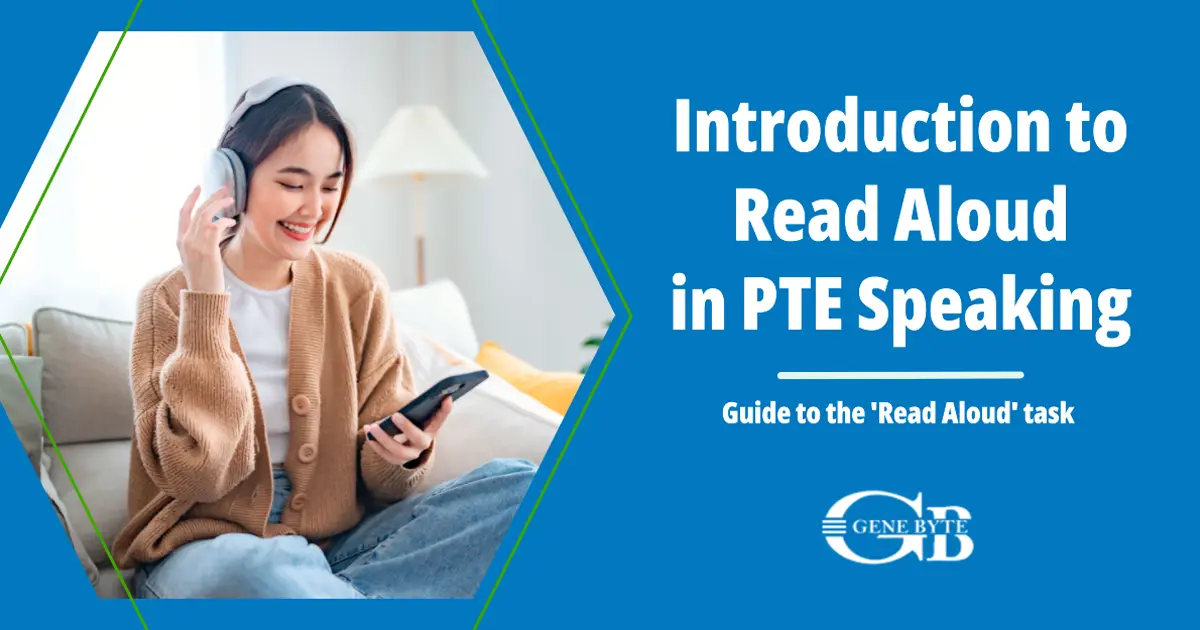Transforming PTE Academic success: Genebyte's AI tools take teacher training to the next level, turning challenges into triumphs in the Read Aloud section.
The Read Aloud task in the Speaking Section of the PTE Academic exam is crucial. It combines reading and speaking skills, testing precision, fluency, and pronunciation.
Key Takeaways:
- The First Task: First task in the speaking section and of the exam.
- Understanding it: Grasp its importance to guide students effectively.
- Skills Tested: Precision, fluency, and clear pronunciation.
- Use Practical Tips: Focus on improving reading and speaking skills.
- Leverage Technology: Use Genebyte's tools to enhance teaching.
By mastering the Read Aloud task, educators can help students excel in the PTE Academic exam. Genebyte's resources support both teachers and students in achieving their goals.

Introduction to Read Aloud in PTE Academic
Definition and Overview of Read Aloud Task
The Read Aloud task follows an unscored Personal Introduction, but it is the actual starting point for the speaking test. It entails reading short texts aloud into a microphone, blending both speaking and reading skills. Each candidate is presented with 6 to 7 texts, with a preparation time of 35 or 40 seconds to read and understand the text, followed by 35 to 40 seconds to read it aloud for recording.
This task is designed to assess a student's ability to read a written text aloud while maintaining fluency, pronunciation, and intonation. It challenges students to manage their time effectively while demonstrating a clear understanding of the text they are reading.
Importance of Read Aloud in PTE Academic
The significance of the Read Aloud task in PTE Academic lies in its dual assessment of reading and speaking skills. It serves as a comprehensive measure of a student's ability to articulate English fluently and accurately. This section not only evaluates the student's pronunciation and oral fluency but also their ability to read and interpret written text under timed conditions.
For students aiming for high scores, especially those targeting 79 and above, excelling in the Read Aloud task is essential. It contributes to their overall performance in the speaking section and influences their cumulative score in the exam.
Relevance to Teachers and Coaching Institutes
For teachers and coaching institutes, understanding the Read Aloud task is paramount. Effective training in this area can significantly impact a student's performance in the PTE Academic exam. As a teacher, it's crucial to equip students with strategies to overcome common challenges such as pronunciation difficulties, managing content accuracy, and adhering to time constraints.
At Genebyte, we recognize the importance of this task and offer AI-based evaluation tools as part of our practice software. These tools assist teachers in coaching institutes to analyze and improve the Read Aloud performance of their students. Through our technology, we aim to enhance the instructional quality of teachers, ultimately reflecting in the improved performance of their students in the PTE Academic exam.

The Structure of the Read Aloud Task
Components of the Task
The Read Aloud task in PTE Academic is a sophisticated test component that evaluates both Speaking and Reading skills. This task involves:
- Reading Preparation: Candidates are given 35 or 40 seconds to read and understand the text.
- Speaking and Recording: Following the preparation, candidates have 35 to 40 seconds to read the text aloud for recording.
This process tests the ability to interpret, articulate, and deliver written content in a spoken format, challenging the candidate's language skills in a comprehensive manner.
Time Management and Length of Texts
Effective time management is crucial in the Read Aloud task. Candidates need to balance their preparation and reading within the allotted time, which includes:
- Preparation Time: 35 or 40 seconds for understanding the text.
- Reading Time: 35 to 40 seconds for speaking the text aloud.
The lengths of the texts are designed to be read comfortably within this timeframe, yet they require focused and efficient reading strategies.
Skills Assessed in the Read Aloud Section
The Read Aloud task assesses a range of skills essential for language proficiency:
- Content Understanding: Ability to comprehend and interpret the text.
- Oral Fluency: Smooth, natural speech delivery without hesitations or unnatural pauses.
- Pronunciation: Clear and accurate articulation of words.
- Time Management: Efficient use of allotted time for reading and speaking.
These skills are integral to the PTE Academic assessment criteria and are indicative of a candidate's overall language proficiency.

Challenges Faced by Students in Read Aloud
Common Difficulties in Fluency
In the Read Aloud task of the PTE Academic exam, fluency is a crucial factor. Many students face challenges in maintaining a smooth, natural rate of speech. Hesitations, repetitions, and false starts are common issues that negatively impact fluency scores. Achieving a consistent and natural rhythm in speech can be a significant hurdle for learners, especially for those not native to the English language.
Common Difficulties in Pronunciation
Pronunciation poses another significant challenge in the Read Aloud task. Students often struggle with the correct articulation of words, especially those with complex or unfamiliar phonetics. The pronunciation score is determined by the clarity of speech and how easily understandable it is to regular speakers of English. This includes the native-like pronunciation of vowels and consonants, as well as correct word stress.
Understanding the Content for Effective Delivery
Understanding and interpreting the content correctly is essential for effective delivery in the Read Aloud task. Students must not only read the text but also comprehend it to convey the intended meaning accurately. This involves identifying key information and understanding the overall context of the text, which can be challenging under timed conditions.
Time Constraints and Their Impact
Time management is a critical aspect of the Read Aloud task. Students often struggle to balance the 35-second or 40-second preparation time with the 35-second or 40-second recording time. Efficiently managing this time while ensuring effective delivery of the content is a common challenge that can significantly affect performance.
Common Challenges in Read Aloud Task
| Challenge Category | Description |
|---|---|
| Fluency | Difficulties in maintaining a smooth, natural speech rate; hesitations and repetitions |
| Pronunciation | Struggles with clear and accurate articulation of words; native-like pronunciation |
| Content Understanding | Challenges in comprehending and interpreting the text effectively |
| Time Management | Balancing preparation and reading time under timed conditions |
Genebyte's Solution to Overcoming These Challenges
Genebyte offers an innovative approach to addressing these challenges. Our AI-based evaluation tools provide detailed feedback on each aspect of the Read Aloud task, allowing teachers to identify and focus on specific areas of improvement for each student. By leveraging Genebyte's technology, educators can enhance their teaching strategies to effectively tackle these common difficulties, thereby improving the overall performance of their students in the PTE Academic exam.

Role of Teachers in Preparing Students for Read Aloud
Teaching Techniques for Fluency
Fluency in the Read Aloud task is critical, and teachers play a vital role in enhancing this skill. Here are some effective teaching techniques:
- Practice with Diverse Texts: Encourage students to practice with a variety of texts to improve adaptability and fluency.
- Use of Audio Recordings: Utilize recordings to help students understand the natural flow and rhythm of spoken English.
- Simulated Test Environment Create a test-like environment for practice, helping students get accustomed to the pressure and timing of the actual exam.
Teaching Techniques for Pronunciation
Pronunciation is another key aspect of the Read Aloud task. Teachers can use the following techniques:
- Phonetic Training: Focus on the phonetics of difficult words, breaking them down for easier understanding.
- Accent Reduction Exercises: Include exercises aimed at reducing heavy accents that might hinder clear pronunciation.
- Regular Speaking Practice: Encourage students to speak regularly in English, focusing on the correct pronunciation of words.
Strategies for Comprehending and Conveying Text Meaning
Comprehension is essential for effective delivery. Strategies include:
- Contextual Learning: Teach students to understand the context of the text, which aids in better interpretation and delivery.
- Key Information Identification: Train students to quickly identify key information in the text that needs emphasis.
- Interactive Reading Sessions: Conduct sessions where students read and explain the text in their own words.
Managing Time and Stress During the Test
Time management and stress control are crucial. Here's how teachers can help:
- Time-bound Practice Sessions: Conduct practice sessions within the same time constraints as the actual test.
- Stress Management Techniques: Teach relaxation and breathing techniques to manage exam stress.
- Mock Tests: Regular mock tests help students get used to the exam format and time pressure.
Effective Teaching Strategies for Read Aloud Task
| Aspect | Strategy |
|---|---|
| Fluency | Diverse text practice, audio recordings, simulated tests |
| Pronunciation | Phonetic training, accent reduction, regular speaking practice |
| Comprehension | Contextual learning, key information identification, interactive reading |
| Time Management | Time-bound practice, mock tests |
| Stress Control | Stress management techniques, relaxation exercises |

Genebyte's Approach to Enhancing Teacher Training
Utilizing Genebyte's AI-Based Evaluation Tools
At Genebyte, we leverage cutting-edge AI technology to transform teacher training in PTE Academic preparation. Our AI-based evaluation tools are designed to closely mimic the scoring algorithms of the PTE Academic exam, providing an unparalleled advantage in training:
- Automated Feedback: Instant, accurate feedback on students' Read Aloud performances, focusing on fluency, pronunciation, and content delivery.
- Detailed Analysis: Breakdown of each student's strengths and weaknesses, enabling personalized training approaches.
- Progress Tracking: Continuous monitoring of students' progress, ensuring measurable improvement over time.
Benefits of Genebyte's Practice Software for Coaching Institutes
Genebyte's practice software offer a suite of benefits tailored to meet the specific needs of PTE Academic coaching institutes:
- Enhanced Training Efficiency: Teachers can focus on targeted areas for improvement, making the training process more efficient.
- Customizable Learning Experience: Ability to tailor training sessions based on individual student performance analytics.
- Scalability: Suitable for institutes of any size, enabling them to cater to a diverse range of students with varying proficiency levels.
Case Studies: Success Stories of Institutes Using our Portals
To illustrate the impact of our solutions, here are brief case studies of institutes that have successfully integrated our technology:
- Global Language Institute: Experienced a 30% improvement in student pass rates in PTE Academic after implementing Genebyte's AI tools for Read Aloud training.
- The English Hub: Reduced the time spent on manual evaluation of practice tests by 50%, increasing overall teaching efficiency.
- Ridhima PTE: Students reported higher confidence and better performance in the Read Aloud section, attributed to personalized feedback and practice sessions provided by Genebyte's tools.
Impact of Genebyte's Solutions on Institutes
| Institute | Impact | Improvement Area |
|---|---|---|
| Global Language Institute | 30% increase in pass rates | Student Performance |
| The English Hub | 50% reduction in evaluation time | Teaching Efficiency |
| Ridhima PTE | Higher student confidence and performance | Personalized Training |

The Importance of Expert Guidance in PTE Read Aloud
The PTE Academic Read Aloud task, while seemingly straightforward, poses unique challenges. Expert guidance is crucial in navigating these challenges and achieving high scores. Here's why expert guidance, like that provided by Genebyte, is vital:
Understanding the Complexity of the Task
Read Aloud is not just about reading text; it's about understanding and delivering it effectively. Experts can help students decipher complex texts and articulate them in a way that meets the exam's standards. They provide insights into nuances such as stress, intonation, and rhythm, which are essential for a high score.
Personalized Feedback and Improvement
Each student has different strengths and weaknesses. Expert trainers can provide personalized feedback, identifying specific areas for improvement. For instance, some might struggle with pronunciation while others may need help with fluency. Tailored guidance ensures that each student receives the attention they need to excel.
Overcoming Common Pitfalls
Common pitfalls in Read Aloud include mispronunciation, incorrect stress, and pacing issues. Experts are adept at identifying these pitfalls and providing strategies to avoid them. This targeted approach significantly improves a student's performance.
Leveraging Technology for Enhanced Learning
Incorporating technology, like Genebyte's AI-based tools, into training can dramatically enhance the learning experience. These tools provide objective, detailed feedback that human trainers might miss, offering a comprehensive view of a student's performance.
Real-Life Example:
- A student, after receiving expert guidance and utilizing Genebyte's AI tools, improved her pronunciation score from 2 (Intermediate) to 4 (Advanced), significantly boosting her overall PTE score.
Benefits of Expert Guidance in Read Aloud
| Aspect | Benefit |
|---|---|
| Complexity Understanding | Insights into text nuances and delivery techniques |
| Personalized Feedback | Tailored improvement plans based on individual needs |
| Pitfall Avoidance | Strategies to overcome common issues in pronunciation and pacing |
| Technology Integration | Enhanced learning with AI-based tools for objective feedback |

Actionable Tips for Teachers and Coaching Institutes
- Focus on Fluency and Pronunciation: Regular practice with diverse texts and phonetic exercises.
- Use Technology: Leverage Genebyte's AI tools for objective feedback and performance analysis.
- Simulated Test Environments: Conduct regular mock tests under real exam conditions.
- Personalized Coaching: Tailor your teaching strategies to address the individual needs of each student, focusing on their specific areas of improvement.
- Personalized Coaching: Tailor strategies to individual student needs, focusing on specific areas of improvement.
- Continuous Learning: Stay updated with the latest PTE Academic trends and training methods.
The PTE Academic Read Aloud task requires skilled reading and clear speech. Expert guidance and personalized training are essential. After this task, students move to the Repeat Sentence question type. Genebyte's software provides teachers with tools and insights to improve training effectiveness and student outcomes in the PTE Academic exam.
Get Started with Genebyte
Enhance your teaching methods with Genebyte's innovative technology. Visit our website, schedule a demo, or contact us for more information. Transform your PTE Academic preparation today.
Frequently Asked Questions
Read Aloud in PTE Academic is a speaking test component where candidates read a short text aloud into a microphone. It assesses both speaking and reading skills, requiring clear articulation, correct pronunciation, and understanding of the text.
In PTE Academic, Read Aloud is the initial segment of the speaking test. Candidates are presented with 6 to 7 short texts, which they must read aloud, testing their ability to read and speak English fluently and accurately.
For the Read Aloud task in PTE, candidates are given 35 or 40 seconds to prepare and understand the text, followed by 35 to 40 seconds to read it aloud.
In the PTE Speaking section, candidates typically encounter 6 to 7 Read Aloud questions.
PTE Read Aloud is scored based on three factors: content accuracy (inclusion of all words in the text), oral fluency (smoothness and naturalness of speech), and pronunciation (clarity and correctness of speech sounds).
While templates are not typically used in Read Aloud, focusing on fluency, pronunciation, and understanding the content is crucial. Moreover there is a special trick where candidate does not have to read everything displayed on the screen. Genebyte's AI-based tools can help teachers guide students in these areas.
- Practice with Diverse Texts: Encourage reading different types of texts aloud.
- Phonetic Training: Focus on challenging words and their pronunciation.
- Mock Tests: Simulate test conditions for practice.
- Personalized Feedback: Use tools like Genebyte's AI-based evaluations to provide specific feedback and track progress.
Genebyte's AI-based evaluation tools offer detailed feedback on fluency, pronunciation, and content delivery, allowing teachers to identify areas for improvement and provide tailored training to students.
Key Points for Read Aloud in PTE Academic
| Aspect | Key Point |
|---|---|
| Task Description | Reading short texts aloud; assessing speaking and reading skills |
| Time Allocation | 35-40 seconds for preparation, 35-40 seconds for reading aloud |
| Number of Questions | 6 to 7 in the speaking section |
| Scoring Criteria | Content, oral fluency, pronunciation |
| Preparation Tips | Diverse texts, phonetic training, mock tests, personalized feedback |
| Genebyte's Role | Providing AI-based evaluation tools for effective training |
